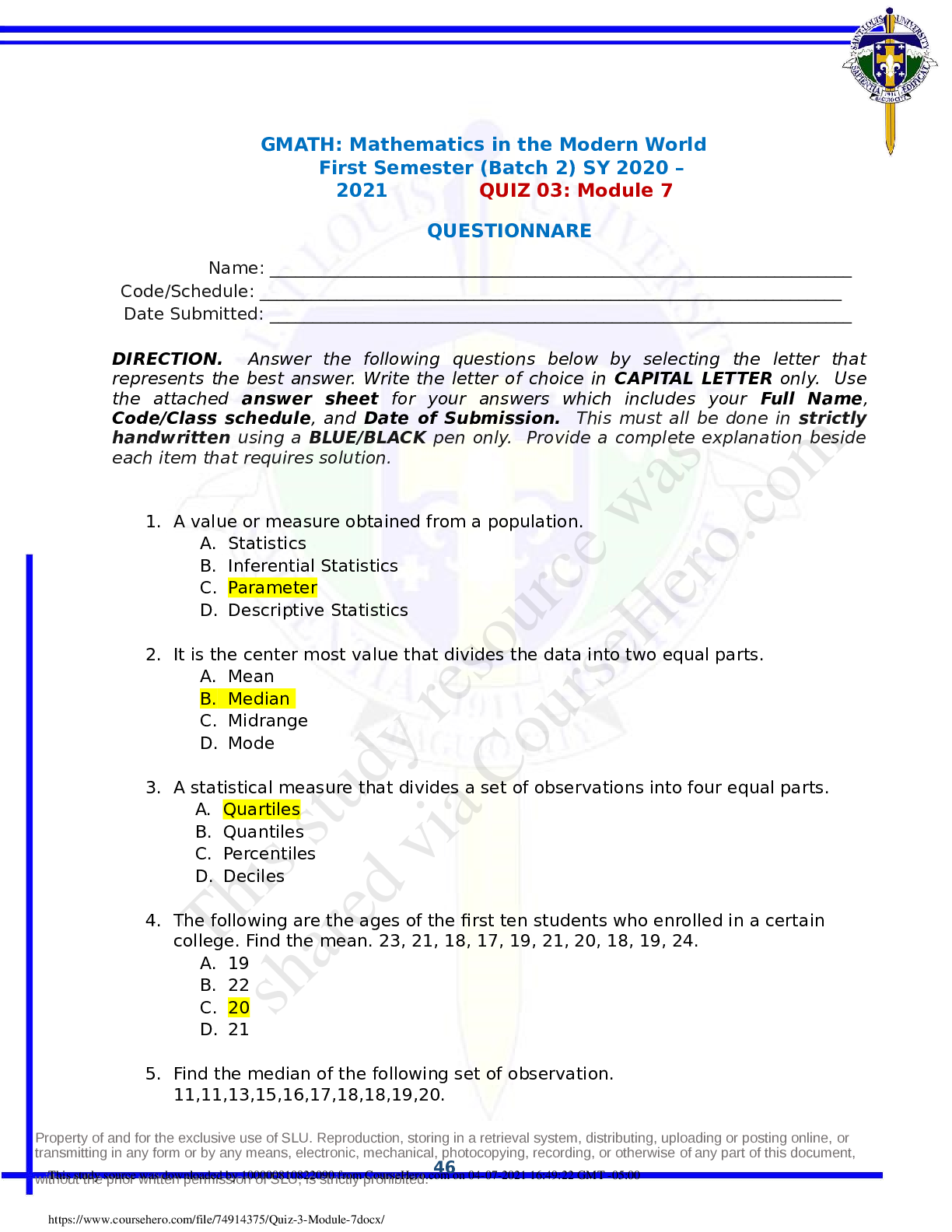*NURSING > EXAM > RNSG 1430 Raising the Bar for Success _ Comfort _ First Semester 2020 – El Centro College | RNSG14 (All)
RNSG 1430 Raising the Bar for Success _ Comfort _ First Semester 2020 – El Centro College | RNSG1430 Raising the Bar for Success _ Comfort _ First Semester 2020
Document Content and Description Below
RNSG 1430 Raising the Bar for Success _ Comfort _ First Semester 2020 – El Centro College Raising the Bar for Success First Semester Comfort What is the definition of comfort? Comfort is ... a state of physical ease. - Describe how pain is a subjective physical and psychosocial experience. What is the difference between younger and older patients when reporting pain? They may not tell you if they are in pain or might describe it differently. Elder patients tend to not tell nurses that they are in pain because they believe it is part of life and they also believe they are being a bug by complaining. Among older people, pain has often been viewed as a natural component of the aging process, being ignored or undertreated by health care providers. -- -- - - - - - - - - - - - - - -- - - - - - - How does chronic pain relate to a patient’s lifestyle? Chronic pain is a pain that people live with. It lasts 6months to a lifetime. - How does peripheral neuropathy affect pain management and nursing care? - What happens to a patient who has unrelieved pain? - How is the Endocrine system affected when pain is present? What is a basic nursing measure to provide comfort to a patient with pain? What is the goal of pain management? The goal is prevent the pain from getting worse. It’s to keep pt.’s at a state of ease/comfort. - How is pain relief determined? - What does the nurse need to ask when performing a pain evaluation? What non-pharmacologic strategies are available for pain management? Alternative therapies: Mind-Body therapy, Biologically-based therapy, Manipulative and body-based therapy, Energy Therapy - - - - - - - - - - - - - - - - - - - - - - - - - - What is an Allopathic Medical Provider? An allopathic physician is a medical doctor who treats disorders and injuries by using methods aimed at counteracting the symptoms to promote healing. How can both non-pharmacologic and pharmacologic strategies be used together to manage a patient’s pain? What is nociception pain? Refers to the normal functioning of physiologic systems that leads to the perception of noxious stimuli (tissue injury) as being painful. ¬ Normal pain transmission ¬ Surgery, trauma, burns, and tumor growth ¬ Aching, cramping, or throbbing How should a nurse assess pain in a pediatric patient? Wong-Baker Faces pain scale Must be done with each assessment Needs to be age specific Requires special techniques Use a consistent pain scale Consider physiologic manifestations Observe behaviors and verbal indicators of pain Point to painful area on a doll or body drawing Point to “where do you need” a band aid Draw a happy or sad face Use age appropriate pain scales Question the child. Use pain-rating scales. Evaluate behavior and physiologic changes. Secure parents’ involvement. Take cause of pain into account. Take action and evaluate results. What is the gate theory in regard to pain? The theory states that certain nerve fibers, those of small diameter, conduct excitatory pain stimuli toward the brain, but nerve fibers of a large diameter appear to inhibit the transmission of pain impulses from the spinal cord to the brain. The exciting and inhibiting signals at the gate in the spinal cord determine the impulses that eventually reach the brain. Past experiences and learned behaviors, which are interpreted by the brain, regulate or adjust the eventual behavioral responses to pain. Thus, the gating mechanism appears to be influenced by the amount of activity in large and small afferent fibers in addition to nerve impulses that descend from the brain. This helps explain why different people interpret similar painful stimuli differently What are the common pharmacologic strategies available for pain relief? How can a nurse prioritize many patients who are in need of pain medication? - - - - - - - - - - - - - - - What should the nurse teach the patient about pain management? In order to manage the pain the pt should prevent the pain before it gets worse. This can be handled by taking pain medication before it gets worse or at a scheduled time What is a herniated nucleus pulposus (HNP)? Herniated nucleus pulposus is a condition in which part or all of the soft, gelatinous central portion of an intervertebral disk is forced through a weakened part of the disk, resulting in back pain and nerve root irritation. What treatment is available for a patient with HNP, how is pain managed? Acetaminophen, NSAIDs, or other analgesics should be used as needed to relieve pain. If symptoms are not relieved with nonopioid analgesics, corticosteroids can be given systemically or as an epidural injection; however, analgesia tends to be modest and temporary Physical therapy and home exercises can improve posture and strengthen back muscles and thus reduce spinal movements that further irritate or compress the nerve root. What is the plan of care for a patient with neuropathic pain? MY COMFORT NOTES: THE FOUR PARTS OF THE PAIN PROCESS: 1. TRANSDUCTION- activation/stimulation of pain receptors. Conversion of painful stimuli to electrical impulses that travel periphery to the spinal cord. Injured tissue releases chemicals that excite or activate nerve endings. A damaged cell releases histamine, nerve endings are excited, lactic acid accumulates in injured tissues by lack of blood supply and excites nerve endings causing pain. 2. TRANSMISSION-occurs as the electrical impulse travels along the nerve fibers, where neurotransmitters regulate it 3. PERCEPTION-Involves the sensory process that occurs when a stimulus for pain is present. It includes the persons' interpretation of pain. The PAIN THRESHOLD is the LOWEST intensity of a stimulus that causes the subject to recognize pain. 4. MODULATION-inhibition or modification of the sensation of pain that is regulated by substances called neuromodulators. (Noradrenaline, Dopamine, Serotonin, Acetylcholine) The process by which the sensation of pain is inhibited or modified is MODULATION. The sensation of pain appears to be regulated or modified by NEUROMODULATORS, which are endogenous opioid compounds in the brain + spinal cord. They have analgesic activity that alters the perception of pain. These include: ENDORPHINS (with the type called DYNORPHIN having the most potent effect) + ENKEPHALINS (thought to reduce pain by inhibiting the release of substance P from the terminals of afferent neurons). The process by which the sensation of pain is inhibited or modified is referred to as modulation. The sensation of pain appears to be regulated or modified by substances called neuromodulators. These neuromodulators are endogenous opioid compounds, meaning they are naturally present, morphine-like chemical regulators in the spinal cord and brain. PAIN IS THE 5TH VITAL SIGN BRADYKININ- powerful vasodilator that increases capillary permeability and constricts smooth muscle - plays an important role in pain at the site of the injury, even before the pain message gets to the brain - triggers the release of histamine BRADYKININ & HISTAMINE-combination with it produces redness, swelling, and pain observed when inflammation is present NEUROMODULATORS- have analgesic activity and alter the perception of pain. Endorphins and Enkephalins-opioid neuromodulators naturally produced by the body. powerful pain blocking chemicals, have prolonged analgesic effects and produce euphoria CUTANEOUS-superficial and involves the skin or subcutaneous tissue. (EX. Paper cut) SOMATIC-involves tendons, ligaments, bone, blood vessels and nerves (ex.post-surgical pain) VISCERAL-originates in body organs in the chest, head and abdomen(kidney stone pain) REFERRED PAIN-Pain that originates in one part of the body but is perceived in an area distant from its point of origin. (heart attack being felt in the neck or arm) Referred pain is a term used to describe discomfort that is perceived in a general area of the body but not in the exact site where an organ is anatomically located. NEUROPATHIC PAIN-results from injury to or abnormal functioning of nerves or nervous system: it’s pathological, burning, sharp, shooting; diabetic neuropathy, phantom pain, degenerative process. An example of neuropathic pain is phantom limb pain or phantom limb sensation, in which individuals with an amputated arm or leg perceive that the limb still exists and that sensation such as burning, itching, and deep pain are located in tissues that have been surgically removed. It is often described as burning, electric, tingling, or stabbing - - - - - - - - - -- - - - - - The PQRST method is a useful way for nurses to assess pain OPQRST- O-nset P-rovokes or palliates- what makes it worse or better Q-uality- pt's description of the pain R-egion and radiation- location S-everity T-ime- changed since onset, history of pain FLACC pain scale-The Face, Legs, Activity, Cry, Consolability scale - good for children or adults who cannot speak Comfort Scale-used when a patient cannot describe or rate their pain ANALGESICS-pharmacologic agent that relieves pain, reduces a persons perception of pain, and alters a person's response to discomfort NONOPIOID ANALGESICS-acetaminophen (Tylenol) Nonsteroidal Anti-inflammatory-NSAIDS- Motrin OPIOD ANALGESICS-Opioids produce analgesia by attaching to opioid receptors in the brain - key fitting a lock opioid receptors are also present on peripheral terminals of sensory nerves and cells on the immune system. (morphine, codeine, hydromorphone- Dilaudid) ADJUVANT DRUGS-anticonvulsants, antidepressants, anti-anxiety/anxiolytic agents Side Effects of Opioid Analgesics-Respiratory depression, sedation, nausea, constipation Physical Dependence of Opioid Analgesics-body physiologically becomes accustomed to long-term opioid therapy and suffers withdrawal if the opioid is suddenly removed Tolerance of Opioid Analgesics-body becomes accustomed to the opioid and need a larger dose each time for pain relief When a patient receives an epidural anesthesia... Careful patient monitoring of their response to the therapy with particular attention to RR and pattern (attached by the anesthesiologist) When a patient receives local anesthesia... Note any allergic responses the pt has had in the past to anesthetic agents Offer emotional support during procedure Observe the pt for adverse effects Protect pt from injury until sensory and motor functions return PCA-is a medication delivery system that allows clients to self-administer safe doses of opioids. morphine, hydromorphone, and fentanyl are typical opioids for PCA delivery When should you conduct reassessment? 30 minutes after initial and are ongoing Distraction-includes ambulation, deep breathing, visitors, television, games, prayer and music Acetaminophen has _____ effects that you should be aware of- HEPATOXIC for constipation, you should, - use a preventative approach (monitoring of bowel movements, fluids, fiber intake, exercise, stool softeners, stimulant laxatives, enemas.) Nociception-The ability to feel painful stimuli Lifetime considerations: Older adults-May believe chronic pain and sleep disorders are an inevitable part of the aging process May be reluctant to report discomfort Misconceptions among providers that older adults feel less pain than younger adults may lead to undertreatment of pain and discomfort May have a higher pain threshold, but often have a lower pain tolerance4 May not express even severe pain verbally if cognitively impaired Are more likely to suffer from sleep disorders Examples of nonpharmacologic, independent nursing interventions that promote comfort include:-- Applying heat or cold as appropriate Providing distractions (e.g., reading material, music, crossword puzzles, humor) Client teaching related to sleep hygiene (a variety of sleep practices that help individuals attain good quality sleep at night) and relaxation techniques Scheduling procedures, medications, meals, and other activities around the client's normal sleep schedule Minimizing environmental stimuli in the hospital setting when possible. Dynorphin-the endorphin having the most potent analgesic effect Endorphins-morphine-like substance released by body that appear to alter perception of pain - - - - - - - - - - - - - - - - - - - - -on side effects associated with opioid use are sedation, nausea, and constipation Respiratory depression is a commonly feared side effect of opioid use If respiratory depression is suspected and the opioid dose is withheld, the patient may be physically stimulated by shaking or using a loud sound, along with reminders every few minutes to breathe deeply. Physical dependence is a phenomenon in which the body physiologically becomes accustomed to long-term opioid therapy and suffers withdrawal symptoms if the opioid is suddenly removed or the dose is rapidly decreased. Tolerance occurs when the body becomes accustomed to the opioid and needs a larger dose each time for pain relief. Opioid Drugs- Alleviate moderate to severe pain. Adverse effects; Constipation, nausea, sedation, mental clouding, respiratory depression, subacute overdose, and dry mouth. NSAIDS: commonly used for arthritis because of the medications’ anti-inflammatory and analgesic effects. Acetaminophen: most widely used. Treats MILD TO MODERATE pain. (lethal when OD. Hepatic toxicity) NSAID Warnings- GI bleeding, ulceration, and perforation of the stomach/intestines. DO NOT use perioperative of coronary artery bypass graft surgery Alternative Pain Therapies 1. Mind-Body Therapy-relaxation, guided imagery, distraction, music therapy, art, dance, meditation, prayer 2. Biologically-based therapy- essential oils, aromatherapy, dietary supplements, herbal therapy 3. Manipulative and body-based therapy- chiropractor, massage, yoga 4. Energy Therapies-touch, magnetic fields Degenerative Disc Disease Progressive degeneration is a normal process of aging and results in the intervertebral disks losing their elasticity , flexibility, and shock-absorbing capabilities Nursing interventions: Assess location, onset, duration, and factors that increase pain and or reduce pain. Use a pain scale to assess pain. Assess vital signs. Assess for drug allergies. Administer prescribed analgesics. Provide rest,heat and or cold therapies Patient education about exercise and weight control. Mixed Pain Syndrome- Unique with multiple underlying and poorly understood mechanisms” Fibromyalgia, some low back pain, and myofascial pain Primary Prevention Secondary Prevention Tertiary Prevention 7 Rights for Medication Administration • Right Medication. Right Medication - This means that the medication that is given is the right medication • Right Patient. • Right Dosage • Right Route • Right Time • Right Reason • Right Documentation non-steroidal anti-inflammatory drug (NSAID). It is associated with gastrointestinal upset. To reduce this side effect the nurse may administer the medication with food Negative pressure exerted through a tube inserted in the stomach removes secretions and gaseous substances from the stomach, preventing abdominal distention, nausea, and vomiting. Instillations in a nasogastric tube after surgery are done when necessary to promote patency; this is not the most common purpose of a nasogastric tube after surgery. When pain is resistant to therapy and persists despite a variety of interventions, it is referred to as intractable. Nurses and physicians together need to determine the appropriate pain treatment *An increase in vital signs may occur briefly in acute pain but may not occur when chronic pain is present. THE PAIN EXPERIENCE Factors to Assess Questions and Approaches Characteristics of the pain Location “Where is your pain? Is it external or internal?” (Asking the patient with acute pain to point to the painful area with one finger may help to localize the pain. Patients with chronic pain may have difficulty trying to localize their pain, however.) Duration “How long have you been experiencing pain? How long does a pain episode last? How often does a pain episode occur?” Quantity Ask the patient to indicate the degree (amount) of pain currently experienced on the following scale: It is also helpful to ask how much pain the patient has (on the same scale) when the pain is at its least and at its worst: Least ____________ Worst ____________ Quality “What words would you use to describe your pain?” Chronology “How does the pain develop and progress?” (If pattern can be identified, interventions early in a pain sequence will often be far more effective than those used after the pain is well established.) “Has the pain changed since it first began? If so, how?” Aggravating factors “What makes the pain occur or increase in intensity?” Alleviating factors “What makes the pain go away or lessen? What methods of relief have you tried in the past? How long were they used? How effective were they?” (Methods of relief currently in effect for hospitalized patients should be apparent from the chart. It is important to verify the use of current orders and their effectiveness with the patient. Outpatients may need to be asked to record a medication profile, a thorough and accurate account of all medications they are taking.) Associated phenomena “Are there any other factors that seem to relate consistently to your pain? Any other symptoms that occur just before, during, or after your pain?” Nursing interventions described in this chapter include establishing a trusting nurse–patient relationship, manipulating factors that affect the pain experience, initiating nonpharmacologic pain relief measures, managing pharmacologic interventions, reviewing additional pain control measures, ensuring ethical and legal responsibility to relieve pain, and teaching the patient about pain. Nursing Manipulating factors to pain: include removing or loosening a tight binder, if permissible; seeing to it that a distended bladder is emptied; taking steps to relieve constipation and flatus; changing body positions and ensuring correct body alignment; and changing soiled linens and dressings that may be irritating the skin. A hungry or thirsty patient may need a snack or a drink to feel more comfortable. NSAIDS: Some can cause gastric side effects, but these symptoms may be preventable if the drug is taken with food or antacids. Adjuvant analgesics include antidepressants, anticonvulsants, corticosteroids, and biophosphonates. Error! Filename not specified. Endorphins are produced at neural synapses at various points along the CNS pathway. They are powerful pain-blocking chemicals that have prolonged analgesic effects and produce euphoria. It is thought that endorphins are released through pain relief measures, such as relaxation techniques. Prostaglandins, substance P, and serotonin (a hormone that can act to stimulate smooth muscles, inhibit gastric secretion, and produce vasoconstriction) are neurotransmitters or substances that either excite or inhibit target nerve cells. - - - - - - - - - - - - - - - - - - - - Transduction, the first process involved in nociception, refers to the processes by which a noxious stimulus, such as a burn, releases of a number of excitatory compounds, which move pain along the pain pathway. Transmission, the second process involved in nociception, is responsible for a rapid reflex withdrawal from painful stimulus. The third process involved in nociception is perception. Imagery is based on the belief that the brain processes can strongly influence pain perception. A dual-mechanism analgesic agent, such as tramadol, involves many different neurochemicals as in the process of modulation. Chemicals that reduce or inhibit the transmission of perception of pain include endorphins and enkephalin, which are morphinelike endogenous neurotransmitters . Acetylcholine, serotonin, and substance P are chemicals that increase the transmission of pain. Visceral pain usually is diffuse, poorly localized, and accompanied by autonomic nervous system symptoms such as nausea, vomiting, pallor, hypotension, and sweating. Neuropathic pain is pain that is processed abnormally by the nervous system. Deeper somatic pain such as that caused by trauma produces localized sensations that are sharp, throbbing, and intense. Chronic pain has a duration longer than 6 months. [Show More]
Last updated: 2 years ago
Preview 1 out of 23 pages
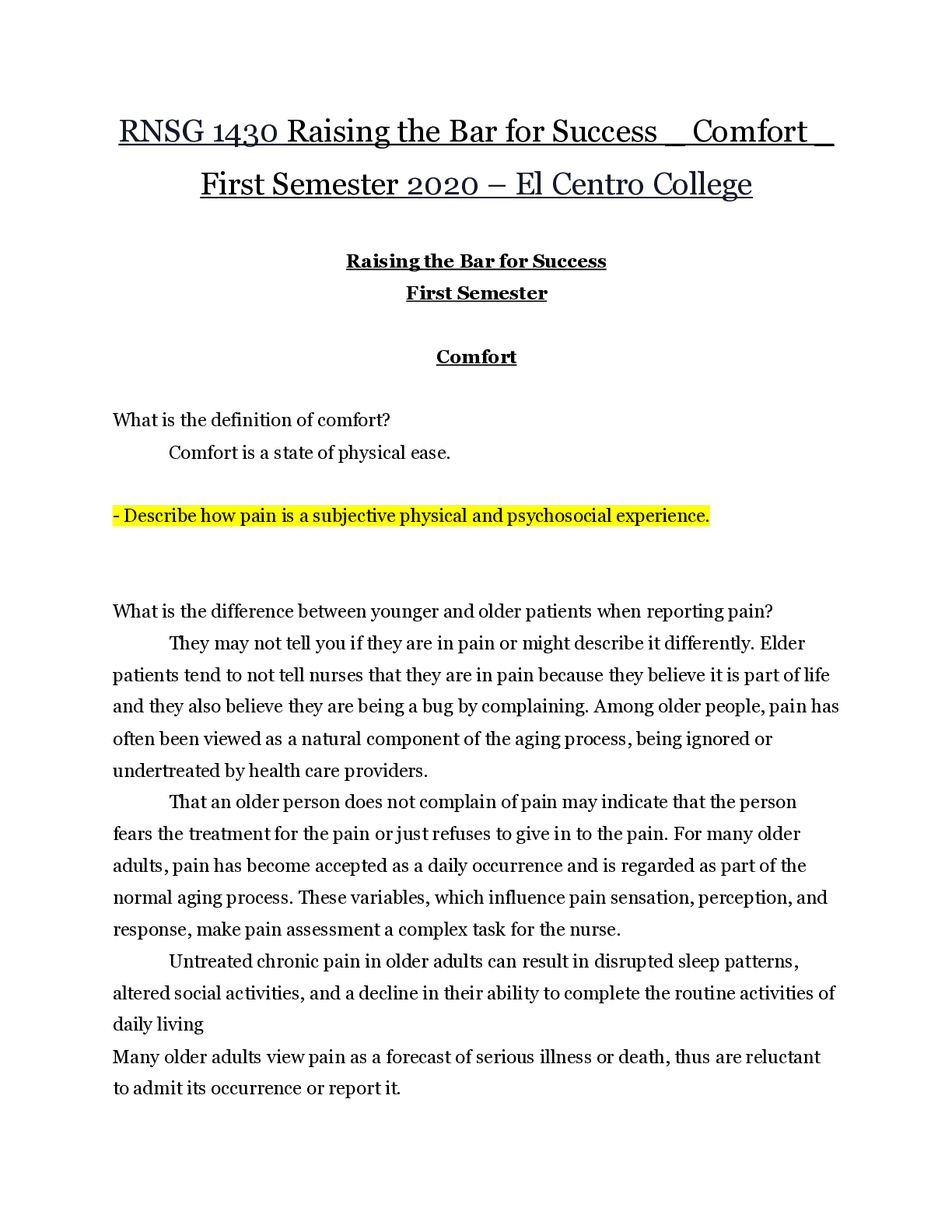
Buy this document to get the full access instantly
Instant Download Access after purchase
Buy NowInstant download
We Accept:

Reviews( 0 )
$12.50
Can't find what you want? Try our AI powered Search
Document information
Connected school, study & course
About the document
Uploaded On
Nov 01, 2020
Number of pages
23
Written in
Additional information
This document has been written for:
Uploaded
Nov 01, 2020
Downloads
0
Views
125








 – University of the People.png)





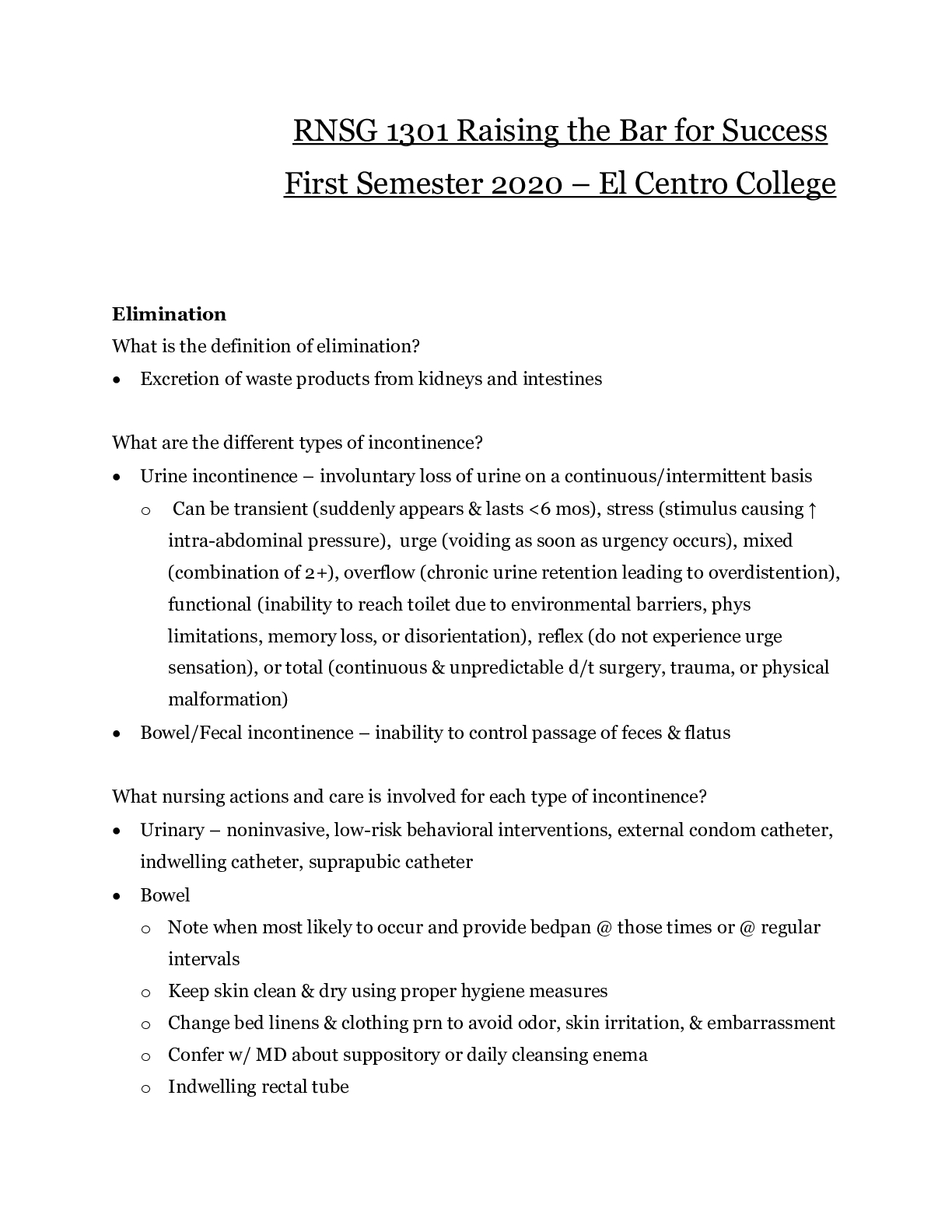


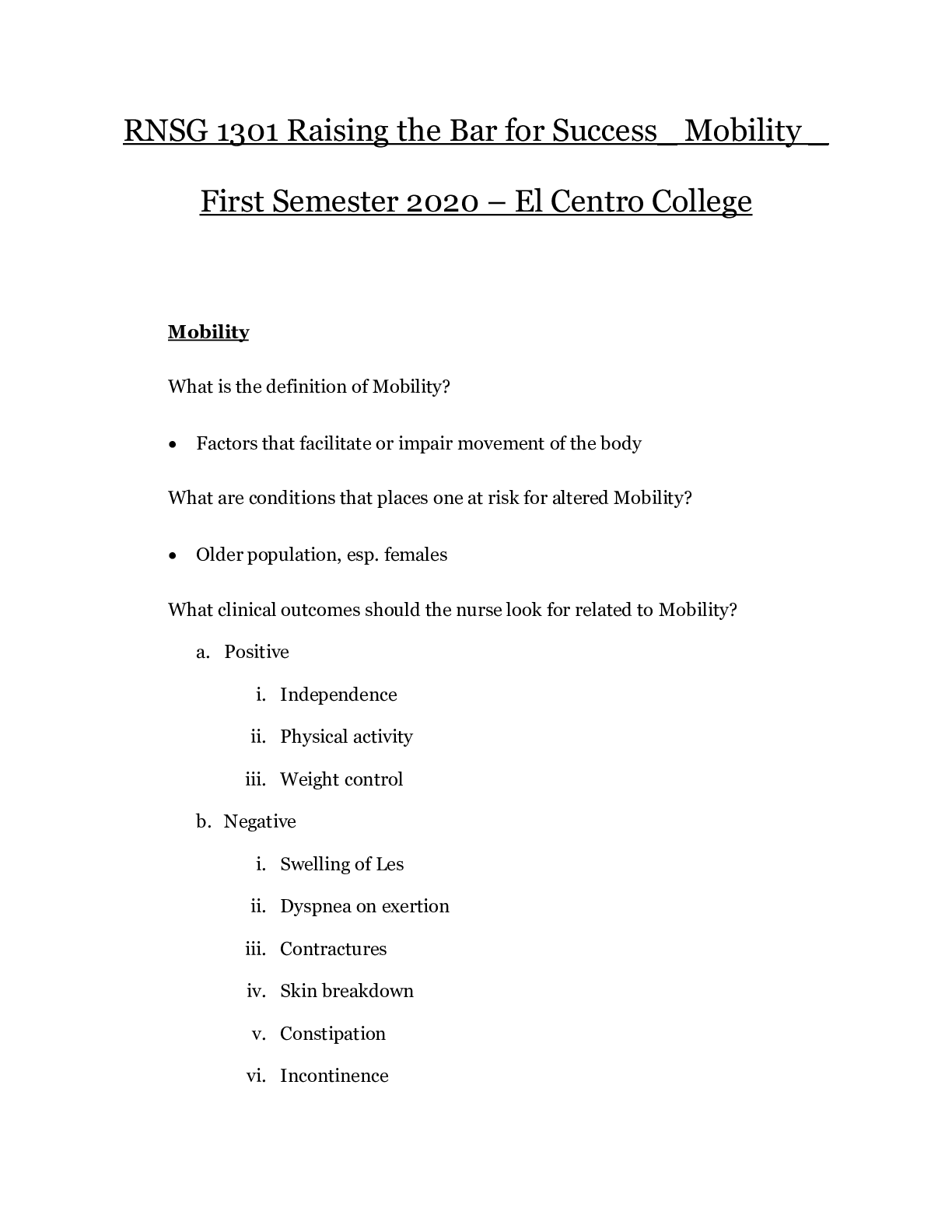
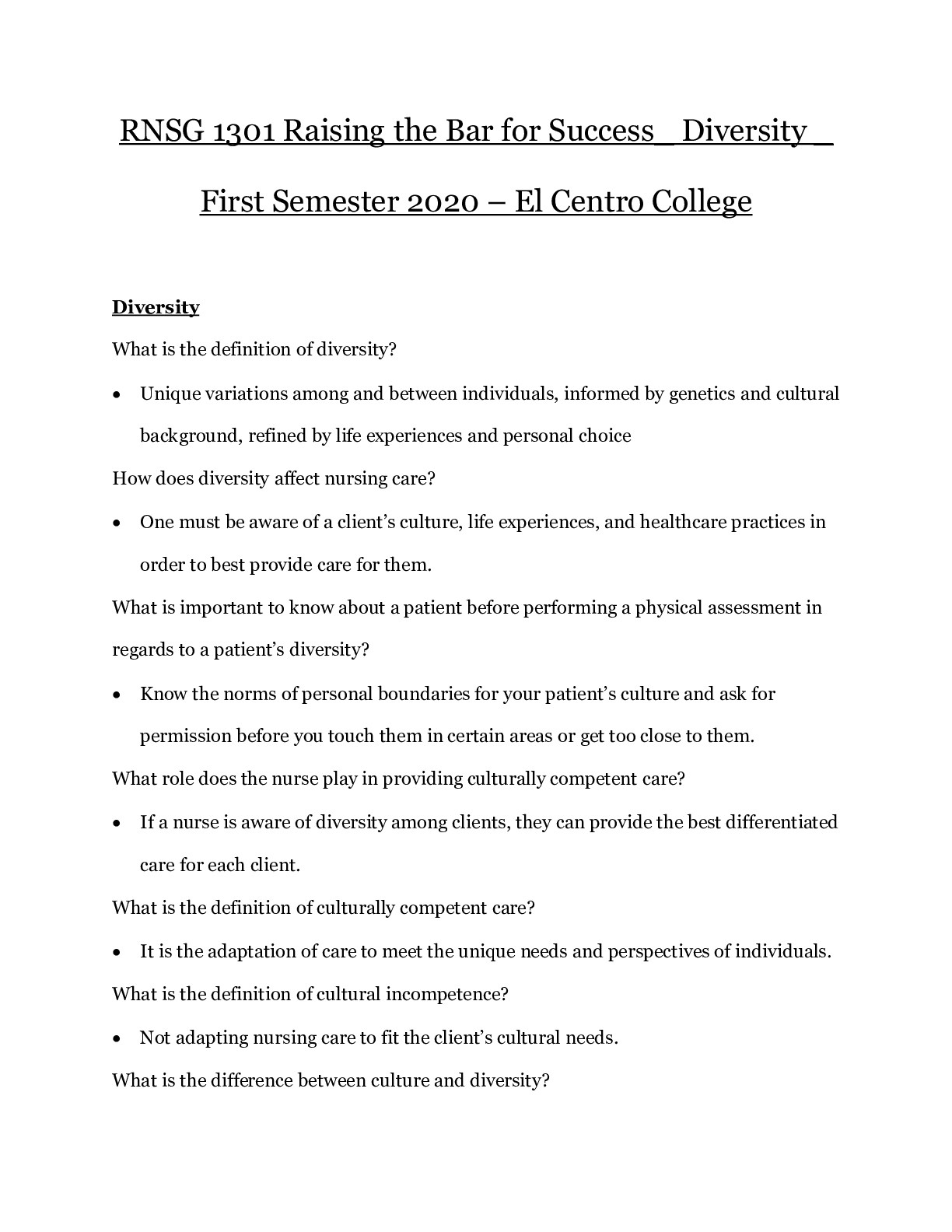

 – El Centro College.png)
 – El Centro College.png)

